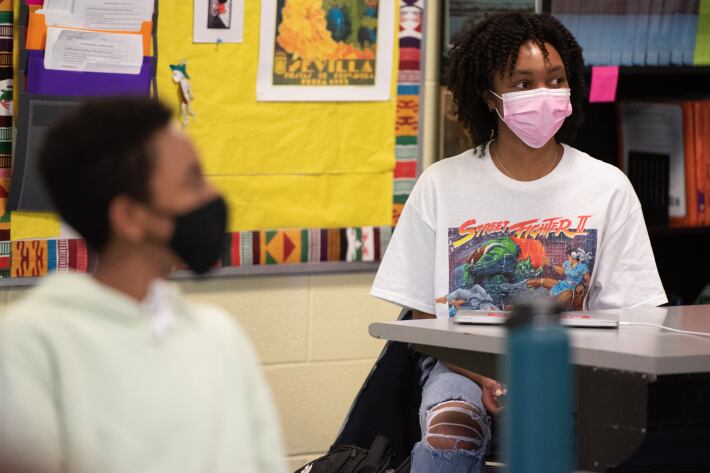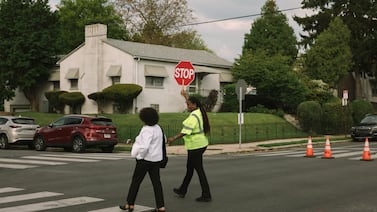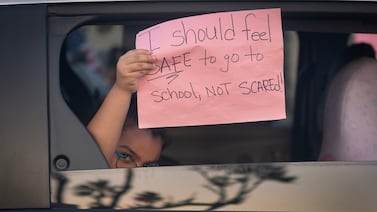In the week before her high school reopened for some in-person instruction, principal Melissa Resh found herself up late one evening wrestling with a COVID-era math problem: How many students could safely fit in the hallway of her school at one time?
Her school, Walter Payton College Preparatory High School, had the highest number of students returning for in-person learning among Chicago’s high schools, and the logistical challenges were huge. She had to juggle teachers’ technology needs, staggered school start times and staff schedules.
“‘I’m just so excited that we have students back in the building,” Resh said.
Chicago reopened its high school buildings for the first time Monday, capping off months of parent pleas, stop-and-start labor negotiations and concerns about new COVID-19 variants.
That effort was celebrated by district leaders, who promised at a Monday press conference held at Payton, that the goal is to open all schools to all students five days a week this fall. “I have been fighting to get our kids back since the beginning of the school year,” schools chief Janice Jackson said. “My goal is to have every kid back in school full time.”
We looked at four lingering questions that have come up in the first few days of the reopening, which could affect what in-person school looks like in the coming months:
What safety protocols are specific to high schools?
Opening high schools is more complicated than reopening campuses for elementary or middle grades. High school students change classes more often, which makes it difficult to establish the strict pod structure that elementary and middle schools have adopted to minimize contact.
Instead, school leaders have been instructed to adapt the normal high school routines to the new reality of COVID-19. That can mean staggered entrance times and passing periods, limited time that students can use restrooms, and putting the responsibility for sanitizing desks on students themselves.
All of these measures are set up to ensure that, in the case of a positive COVID-19 test in a high school, the district’s team of contact tracers will be able to make recommendations for who should quarantine.
Right now, the district said there are 12 contact tracers, along with several other employees managing the program, who will be the backbone of Chicago’s COVID-19 alert system in schools, and support for a total of 30 contact tracing positions if additional capacity is needed.
What will the remote experience be like for students staying home or learning online in classrooms?
Chicago school buildings may be open for all students, but remote learning is still a part of most school days.
First, not all students have returned for in-person learning. Some 26,000 high school students were expected to return to in-person classrooms, or 35.6% of eligible students, according to district figures released last week. Nearly two-thirds of the city’s 73,000 eligible high school students will continue learning from home.
And many of the students who opted into in-person learning will continue to learn from home most of the week. The district is implementing a three-tiered reopening schedule that would have students at the biggest high schools returning to buildings as little as one day a week, those at medium-sized schools coming back two days a week, and at smaller schools, students learning in person four days a week.
High school students, along with many parents, have been more vocal on what they’d like to see in school this year and next. Many want the option for schooling five days a week. But students have also said they want less computer time, more access to counselors, and less grading.
For Resh at Payton, creating a school culture that bridges the in-person and remote experiences was important. Teachers at the school used multiple screens to engage with both sets of students, and they held ice breakers and small group discussions to open the door for some social-emotional engagement.
“We wanted to make sure that there was intentional work around community building for at-home and in-person students,” she said. “How does everyone feel connected in that?”
With all school buildings open, can Chicago keep them fully staffed?
After issuing nearly 6,000 remote work accommodations to teachers and other staff in the first stage of reopening this winter, officials called back most teachers this spring, citing broad access to vaccination appointments and the expectation that more students will opt for in-person learning in the fourth quarter.
So far, most information shared publicly shows the district has been able to avoid major staffing crunches. About 90% of the expected in-person high school staff have returned to school buildings, according to district officials. Some schools also have additional support staff and cadre substitutes where needed, part of the 2,000 additional staff the district promised to hire to support reopening.
Jackson, speaking at a press conference to mark high school reopening on Monday, said staffing had certainly been a challenge when reopening elementary schools but was no longer immediately urgent. “We feel extremely confident that we have the staff in our buildings to provide instructional programs,” she said.
School leaders say that having committed in-person staff is crucial, but the complicated day-to-day realities of staffing amid COVID-19 mean that even with most staff returning, having adults where they need them is not a given. In-person staff, including those who are vaccinated, must complete a daily health screener and, if they have any symptoms that might be COVID-19 related, remain home.
That leaves principals to rearrange schedules or pull other teachers to supervise those classes. At Payton, where the vast majority of staff members have returned, Resh said staffing remains her most urgent question.
Preparing for that includes having a schedule showing when certain staff members can fill in for classroom teachers, and having an understanding throughout the building that staff may have to step in to fill those gaps, she said.
“It’s the constant threat,” she said. “How will we put the right adults in the right spaces?”
When and how will students get vaccinated?
With older students more likely to catch and spread COVID-19 than younger students, and Illinois further along in its vaccination efforts than in earlier reopenings, whether high school students would get the shot, and how, was a much bigger part of the school reopening negotiations this spring.
The teachers union made vaccines for students and their families a part of its demands over the high school reopening agreement. In the final agreement, the district agreed to ensure that students and families in the top one-fifth of Chicago communities most vulnerable to COVID-19 could access vaccines, and use district-run clinics to help make it happen. Chicago Public Schools also said it will offer shots at district-run sites to students who are 18 years or older, and work with the union and health department to help students and their families access vaccine opportunities through informational flyers.
That’s on top of broader access: On Monday, Chicago made all adults age 16 and older eligible to receive a vaccine, though snagging vaccines in easy-to-access city sites has been a challenge.
Available doses may not translate immediately into easy access for appointments, especially in Chicago, where the health department head has encouraged residents to drive to nearby Indiana because that state has shorter wait times for an appointment.






